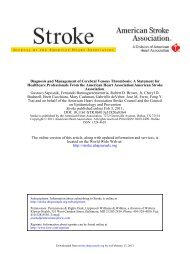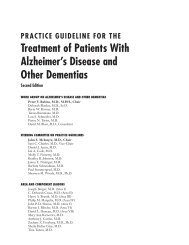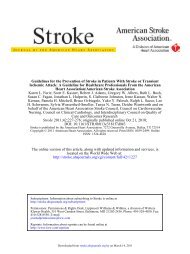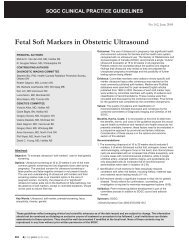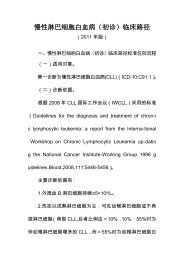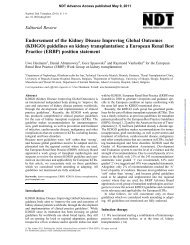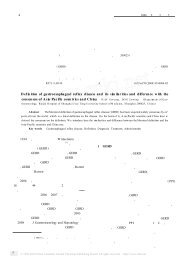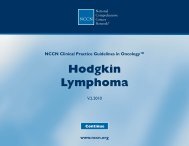EFNS guidelines on pharmacological treatment of neuropathic pain
EFNS guidelines on pharmacological treatment of neuropathic pain
EFNS guidelines on pharmacological treatment of neuropathic pain
Create successful ePaper yourself
Turn your PDF publications into a flip-book with our unique Google optimized e-Paper software.
1160 N. Attal et al.Although many RCTs were performed in low back<strong>pain</strong>, no trial c<strong>on</strong>sidered radiculopathy <strong>pain</strong> as a primaryoutcome. Regarding CRPS, most trials includedpatients with CRPS I or used sympathetic nerve blocks[class I SR: 108].Neuropathic <strong>pain</strong> due to cancer infiltrati<strong>on</strong>Gabapentin (up to 1800 mg/day) in additi<strong>on</strong> to opioidsinduced modest benefit <strong>on</strong> <strong>pain</strong> and dysesthesia in <strong>on</strong>elarge (n ¼ 121) class I RCT [109]; GBP was generallywell tolerated, with no difference in dropouts comparedwith placebo. One RCT <strong>on</strong> low-dose amitriptyline (30–50 mg/day) for 10 days <strong>on</strong>ly, reported a modest effect<strong>on</strong> maximal but not average <strong>pain</strong>, combined withopioids [class II: 110].Post-traumatic/post-surgical <strong>neuropathic</strong> <strong>pain</strong>Three studies were performed in post-mastectomy <strong>pain</strong>and <strong>on</strong>e in mixed post-surgical <strong>pain</strong> related to cancer.One small (n ¼ 15) class II study showed efficacy <strong>of</strong>amitriptyline (25–100 mg) <strong>on</strong> <strong>pain</strong>, sleep and dailyactivities [111]; side-effects caused four early dropoutsand most patients disc<strong>on</strong>tinued <strong>treatment</strong> after thestudy.In <strong>on</strong>e small (n ¼ 13) class II RCT, characterized bya remarkably high resp<strong>on</strong>se to placebo, low-dose venlafaxine(37.5–75 mg/day) was effective <strong>on</strong> maximal<strong>pain</strong> and <strong>pain</strong> relief, but not <strong>on</strong> average <strong>pain</strong> [112].Topical capsaicin (0.075%) was reported generallyefficacious in a large class I trial in post-surgical <strong>pain</strong>[113], whereas in a small class II study in post-mastectomy<strong>pain</strong> it gave negative effects <strong>on</strong> steady <strong>pain</strong> andpositive effects <strong>on</strong> jabbing <strong>pain</strong>, category <strong>pain</strong> intensityand <strong>pain</strong> relief [114]. Both studies used a neutral placebo,which may induce a bias due to the burningsensati<strong>on</strong> engendered by capsaicin.There is evidence regarding the inefficacy <strong>of</strong> propranololin post-traumatic nerve lesi<strong>on</strong>s [class II: 115] orcannnabinoid spray <strong>on</strong> <strong>pain</strong> after brachial plexusavulsi<strong>on</strong> [class I: 116].Phantom limb <strong>pain</strong>In a small (n ¼ 19) class II RCT, GBP titrated to2400 mg/day was effective <strong>on</strong> <strong>pain</strong> but had no effect<strong>on</strong> mood, sleep, or activities <strong>of</strong> daily living [117].Morphine sulphate (70–300 mg/day) was effective in<strong>on</strong>e small (n ¼ 12) class II RCT, but most patientsand therapists recognized the active <strong>treatment</strong>, whichmight unmask the blinding; there was a significantreducti<strong>on</strong> <strong>of</strong> attenti<strong>on</strong> in morphine-treated patients[118].There is evidence regarding the inefficacy <strong>of</strong> memantine30 mg/day [class I: 119] or amitriptyline125 mg/day [class II: 120].Guillain–Barre´ syndromeTwo short-durati<strong>on</strong> (7 days) class II RCTs used GBPcombined with opioids <strong>on</strong> demand. Gapapentin wassuperior to placebo in <strong>on</strong>e study [n ¼ 18; 121] andsuperior to CBZ in another [n ¼ 36; 122], with rapid(day 2–3) reducti<strong>on</strong> <strong>of</strong> both <strong>pain</strong> and opioid c<strong>on</strong>sumpti<strong>on</strong>.A systematic search by a c<strong>on</strong>sensus group <strong>on</strong>Guillain–Barre´ syndrome supports the use <strong>of</strong> GBP orCBZ in the intensive care unit in the acute phase, whilstappropriate opioids may be used but require carefulm<strong>on</strong>itoring <strong>of</strong> adverse effects in the setting <strong>of</strong> aut<strong>on</strong>omicdenervati<strong>on</strong> [SR: 123].Multiple-aetiology <strong>neuropathic</strong> <strong>pain</strong>sTrials in multiple-aetiology <strong>neuropathic</strong> <strong>pain</strong> included alarge proporti<strong>on</strong> <strong>of</strong> patients with CRPS or radiculopathy.In patients with peripheral <strong>neuropathic</strong> <strong>pain</strong>,there is evidence for the efficacy <strong>of</strong> the antidepressantsbupropi<strong>on</strong> 150 mg [class I: 124], clomipramine [class II:125,126], nortriptyline [class II: 125], CBZ [class II:127], and for topical lidocaine [71, discussed in ÔEffects<strong>on</strong> <strong>pain</strong> symptoms and signsÕ]. Discrepant results werereported for mexiletine [class I: 128,129] with positiveeffects <strong>on</strong>ly <strong>on</strong> mechanical allodynia in <strong>on</strong>e study [129].Results with the NMDA-antag<strong>on</strong>ist riluzole were negative[class II: 130] and <strong>on</strong>e study was also negative withfixed dose morphine [class II: 127].Four RCTs examined the effects <strong>of</strong> opioids [76, seeÔCentral <strong>pain</strong>Õ], dextromethorphan [negative results,class II: 131] GBP [class II: 132] or the cannabinoidCT3 (positive results, class I: 133) in patients withmultiple-aetiology peripheral or CP. The GBP studywas positive <strong>on</strong>ly at some time points <strong>on</strong> burning<strong>pain</strong> and hyperalgesia, but not <strong>on</strong> shooting <strong>pain</strong>;these poor results are possibly due to the inclusi<strong>on</strong> <strong>of</strong>a large group <strong>of</strong> patients without evidence <strong>of</strong> nervelesi<strong>on</strong> (CRPS type I), who may be more refractory tothe drug.In two class III trials, the aetiology was not menti<strong>on</strong>edat all, <strong>on</strong>e with LTG 200 mg/day was negativeand the other with capsaicin al<strong>on</strong>e or combined withtopical doxepine was positive <strong>on</strong> several <strong>pain</strong> symptoms[134,135].Recommendati<strong>on</strong>sSeveral less studied <strong>neuropathic</strong> c<strong>on</strong>diti<strong>on</strong>s, such asphantom limb <strong>pain</strong>, post-surgical <strong>neuropathic</strong> <strong>pain</strong> andGuillain–Barre´ syndrome, appear to be similarlyresp<strong>on</strong>sive to most current drugs used in other <strong>neuropathic</strong>c<strong>on</strong>diti<strong>on</strong>s (e.g. TCAs, GBP, opioids), but resultsare based <strong>on</strong> a limited number <strong>of</strong> generally class IIRCTs with small sample sizes (level B). Neuropathic<strong>pain</strong> due to cancer infiltrati<strong>on</strong> seems to be moreÓ 2006 <str<strong>on</strong>g>EFNS</str<strong>on</strong>g> European Journal <strong>of</strong> Neurology 13, 1153–1169



